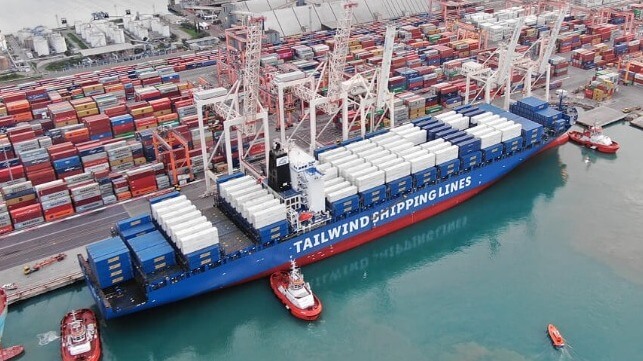German Retailer Lidl Beats Odds Building Niche Shipping Line

German retailing giant Lidl, part of the Schwarz Group, the fifth-largest retailer in the world, surprised many in the shipping industry when it leaked out in the spring of 2022 that they were launching a container shipping line. Frustrated by delays and shortages during the surge in container volumes after the pandemic, Lidl launched Tailwind Shipping Lines in July 2022, but unlike many of the other niche companies started at the time they have succeeded.
Two years after the shipping line started, they note the fleet has grown to a total of nine ships, with its largest to date recently starting service. The Hamburg-based shipping company was originally planned to exclusively move non-food sector cargoes for Lidl from Asia to Europe. Tailwind later expanded to offer capacity to other customers and reports it has a growing number of third-party customers in addition to continuing to service its parent company.
Lidl currently operates 12,350 stores and 225 distribution and logistics centers in 31 countries. Like all modern superstores, Lidl in addition to its fresh food has a broad range of consumer goods including household items and hardware.
“We have established ourselves on the market as a premium service provider that transports goods to and from Asia,” says Christian Stangl, Managing Director of Tailwind Shipping Lines. “In doing so, we are fast, on time, and reliable. This is an essential service for us at Lidl, in particular, given our fixed promotion schedule and special offers that change on a weekly basis.”
Tailwind carved out a nice within the larger industry. The company owns two vessels, Panda 001 (68,228 dwt with a capacity of 5,527 TEU) and Panda 002 (9,312 dwt with a capacity of 800 TEU) while the others are chartered. The new Panda 006, formerly the Kea, is 80,000 dwt with a capacity of 6,800 TEU. The fleet ranges in capacity from 800 TEU to 1,700 in the smaller ships and five ships above 5,000 TEU each. Total capacity among the nine vessels of over 35,000 TEU.
Using smaller vessels, Tailwind focuses on regional ports close to major trading hubs and limits port calls on its routes. The primary route is from China to Barcelona, Spain and Koper, Slovenia. By calling at smaller, less frequented ports Tailwind asserts it avoids delays and can shorten turnaround times. They said they can avoid long waits for berths which permits it to consistently be at the top of the league charts for schedule reliability and punctuality.
Tailwind also established two feeder routes. One operates between Chattogram, Bangladesh and Colombo, Sri Lanka. The other runs between Barcelona, Spain and Moerdijk in the Netherlands.
Many regional shipping companies and non-shipping companies that were drawn into the international container business retreated when the surge in volumes dried up and pricing collapsed in 2023. Tailwind points to its niche strategies and notes even with the diversions like the major carriers away from the Red Sea it has been able to maintain its service.
No comments:
Post a Comment